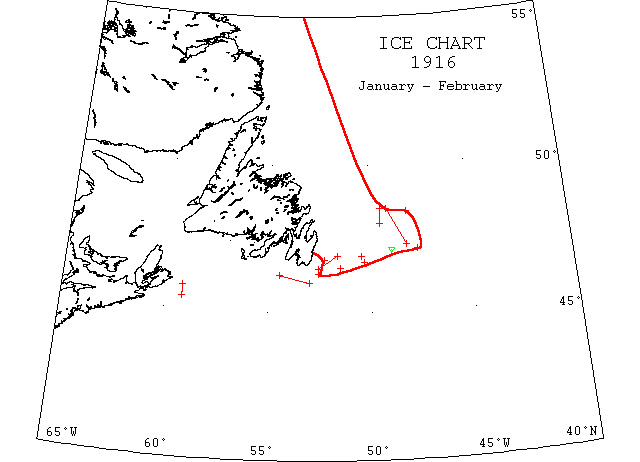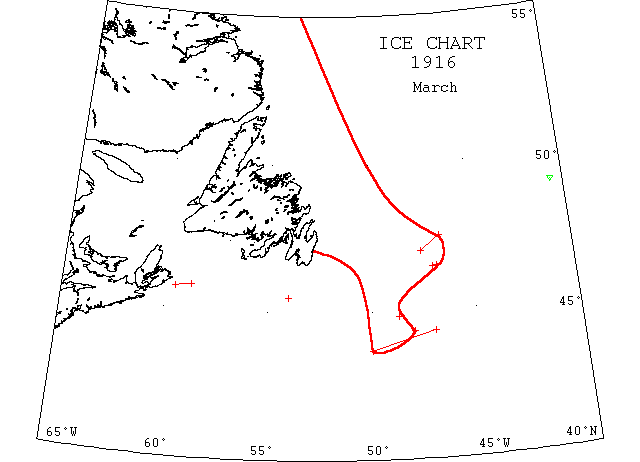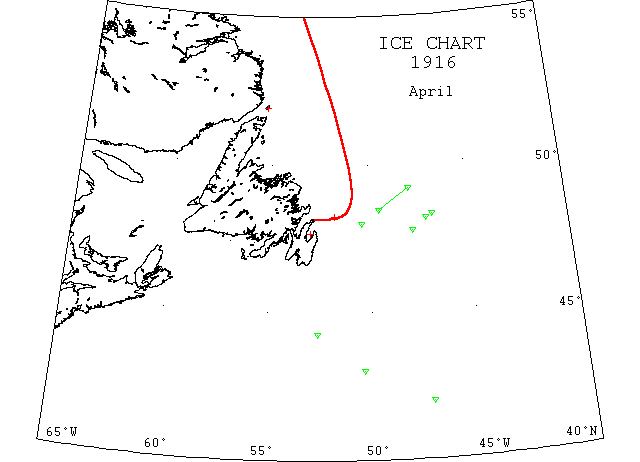January/February

Jan 21 SS “Mississippi” 27(?)07’N (47 maybe) 4856’W, 2 bergs the larger being long and flat.
Jan 27 SS “Rio Verde” 3334’N 7032’W ice in the shape of a hummock 2′ high and 40′[30′ – JH] in circumference. This is the furthest south ice has been seen in years.
Feb 15-17 SS “Petrolite” 4830’N 4910’W encountered heavy ice with lanes of clear water in it; ran S 11W for 40m then S 62W for 30m before clearing ice; 17th, 4548’N 5912’W met heavy close packed ice which extended to the north and west as far as could be seen; steered S for 25m before losing sight of the ice.
Feb 19-20 Steamer reports 4707’N 4739’W sighted an immense strip of field and drift ice, ~200 yards wide, extending as far as could be seen in a NNW-SSE direction; 4654’N 5027’W encountered field and drift ice in strips, which became more numerous and heavier; 20th, 4630’N 5130’W the fields became so large and numerous as to almost stop the vessel and had to put back toward ENE and E to avoid damage; 4642’N 5019’W saw last of the ice.
Feb 20-21 SS “Noorderdijk” 4825’N 4807’W passed through small fields of light pack ice extending for miles around; 21st, 4648’N 5218’W to 4618’N 5235’W passed through quantities of field ice with occasional stretches of open water.
Feb 21-22 SS “Brindilla” 4830’N 4928’W to 48N 4928’W dangerous field ice; 22nd, 4656’N 5137’W to 4629’N 5235’W thick field ice.
Feb 24 SS “Sagona” from Louisburg to Port aux Basques with 2 propeller blades broken by ice.
Feb 26 “Seneca”: 46N 53W to 4615’N 5430’W field ice.
March

Mar 7 4420’N 48W passed through light field ice for 2 hours.
Mar 7-8 “Seneca” 4530’N 54W field ice; 8th, no ice south of 4530’N.
Mar 11 4732’N 4634’W to 4702’N 4729’W very thick field ice.
Mar 11 SS “Noordam” 4418’N 47W to 4340’N 50W field ice.
Mar 12 Halifax: Dangerous ice fields in the track of shipping are reported tonight by the Canadian Marine department. The ice stretches from 4550’N 5845’W to 4545’N 5930’W. It is believed that the floes also extend more to the eastward.
Mar 14 SS “Quebra” 4630’N 4645’W to 4630’N 4657’W passed through some field ice
Mar 22 SS “Cliftonian” 49N 4037’W passed numerous large icebergs.
Mar 22 SS “Nordkyn” at Coppenhagen from Baltimore encountered heavy ice and sprung a leak.
Mar 27 4450’N 4842’W ice was sighted.
April

Apr 4 Belle Isle: heavy open ice stationary.
Apr 6 Scatari: light open ice everywhere.
Apr 10 “Seneca” 4426’N 4957’W no ice.
Apr 11 SS “Magdala” 4817’N 4649’W passed a large berg; 4810’N 4707’W a small berg and 4745’N 4750’W a growler.
Apr 13 SS “Nordland” 4911’N 4757’W to 4827’N 4932’W saw 6 large bergs and quantities of small pieces of ice.
Apr 14 Schooner “Gertrude L” from Catalina for Lisbon put into St. John’s after contact with ice on the Grand Banks.
Apr 24 SS “Communipaw” 4905’N 3648’W a piece of ice 100′ long and 50′ wide showing 4′ out of the water.
Apr 27 “Seneca” 4158’N 4716’W, 4 bergs.
Apr 28- May 1 “Tampa”: 4415’N 5238’W 4 bergs; 29th, 4913’N 38[!]43’N and 48N 5025’W sighted bergs; May 1, 4349’N 4907’W no ice.
May 1 SS “Sandefjord” 5605’N 4820’W a very large berg and 10m south a small one.
May 1 “Tampa” (USCG) 4643’N 4810’W large berg and several floes; 4653’N 4745’W a large berg.
May 2 Schooner “Lila D. Young” left St. John’s for Spain. Turned about May 5 250m from Cape Spear leaking badly from around rudder casing. No ice mentioned. Sank later that year. (#494).